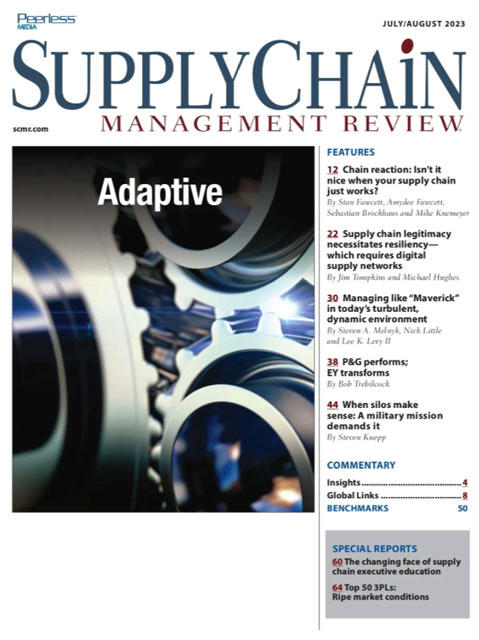Sorry, but your login has failed. Please recheck your login information and resubmit. If your subscription has expired, renew here.
July-August 2023
Most business people have heard the phrase “move fast and break things.” But how do you move fast, break things, and remain profitable? Inside this issue of Supply Chain Management Review are the answers—we hope. We have two articles this month that address decision-making. The articles (“Chain reaction: Isn’t it nice when your supply chain just works?” and “Managing like ‘Maverick’ in today’s turbulent, dynamic environment”) approach the topic of decision-making from decidedly different perspectives, but I believe they are more similar than they appear. Browse this issue archive.Need Help? Contact customer service 847-559-7581 More options
As digital technologies spawn new possibilities, they fuel innovation for new business models and business operating model functions across the value chain to generate differentiating capabilities, transformed processes, and a superior customer experience. The ecosystem e-commerce market is disrupting traditional warehouse operations offering both opportunities and challenges, especially in the 3PL market.
As the broader value chains enter hyper-innovation cycles, the warehouse management function also sees its fair share of innovation. It is generally thought to be a unique “inside the four walls” operation that is operationally quick to respond and slow to innovate. Market evidence suggest a slow pace to digital transformation by shippers. However, as digital technologies converge and the retail market shifts more rapidly to e-commerce, failure to adopt and adapt can be disruptive to the 3PL market and even existential.
Market leaders are leveraging digital transformation to innovate servitization opportunities
One such innovation is the pay-per-use servitization of warehouse space, resources, processes, and information. Digitalization of logistics is emerging as warehouse as a service (WaaS) offerings (see Figure 1).
The market conditions and evolving customer requirements advancing logistics to this new WaaS frontier are as follows.
- Small start-ups to mid-size B2C/B2B businesses seeking ways to set up and expand omni-channel distribution/fulfillment capabilities without having to focus on locations, facilities, warehouse labor recruitment and training, etc., preferring to concentrate on their products and effectively marketing them to build sales while minimizing distribution assets.
- Service expectations and double-digit growth of B2C and B2B e-commerce are driving the need to position products more flexibly and dynamically based on a customer’s pickup/delivery preferences. Research suggests that consumers prefer time-definite delivery performance over speed.
- WaaS is not solely used for B2C. Large organizations with a defined network are looking for storage to support seasonality, adapt to omni-channel, or are evolving their physical distribution network to support omni-channel fulfillment transformation. They are looking to test new service offerings, for example less than one-day delivery lead time or launching a brand into a new geography.
- With the growing digitization of supply chain ecosystems and non-linear product flows, WaaS can offer the flexibility to dynamically position products for optimal customer service and performance.
- Pandemic-like disruptions are illuminating the mandate for organizations to build a set of resiliency capabilities deemed critical to keep customer-promised SLAs. As part of the resiliency strategy, the latency and contractual obligations often inherent in expanding their private distribution network are no longer acceptable.
- Constrained labor availability and growing costs are prompting organizations to pursue advanced automation and robotics in their warehouse operations. This can be hard to contemplate for cash-strapped businesses to undertake independently.

This complete article is available to subscribers only.
Log in now for full access or start your PLUS+ subscription for instant access.
SC
MR
Sorry, but your login has failed. Please recheck your login information and resubmit. If your subscription has expired, renew here.
July-August 2023
Most business people have heard the phrase “move fast and break things.” But how do you move fast, break things, and remain profitable? Inside this issue of Supply Chain Management Review are the answers—we… Browse this issue archive. Access your online digital edition. Download a PDF file of the July-August 2023 issue.As digital technologies spawn new possibilities, they fuel innovation for new business models and business operating model functions across the value chain to generate differentiating capabilities, transformed processes, and a superior customer experience. The ecosystem e-commerce market is disrupting traditional warehouse operations offering both opportunities and challenges, especially in the 3PL market.
As the broader value chains enter hyper-innovation cycles, the warehouse management function also sees its fair share of innovation. It is generally thought to be a unique “inside the four walls” operation that is operationally quick to respond and slow to innovate. Market evidence suggest a slow pace to digital transformation by shippers. However, as digital technologies converge and the retail market shifts more rapidly to e-commerce, failure to adopt and adapt can be disruptive to the 3PL market and even existential.
Market leaders are leveraging digital transformation to innovate servitization opportunities
One such innovation is the pay-per-use servitization of warehouse space, resources, processes, and information. Digitalization of logistics is emerging as warehouse as a service (WaaS) offerings (see Figure 1).
The market conditions and evolving customer requirements advancing logistics to this new WaaS frontier are as follows.
- Small start-ups to mid-size B2C/B2B businesses seeking ways to set up and expand omni-channel distribution/fulfillment capabilities without having to focus on locations, facilities, warehouse labor recruitment and training, etc., preferring to concentrate on their products and effectively marketing them to build sales while minimizing distribution assets.
- Service expectations and double-digit growth of B2C and B2B e-commerce are driving the need to position products more flexibly and dynamically based on a customer’s pickup/delivery preferences. Research suggests that consumers prefer time-definite delivery performance over speed.
- WaaS is not solely used for B2C. Large organizations with a defined network are looking for storage to support seasonality, adapt to omni-channel, or are evolving their physical distribution network to support omni-channel fulfillment transformation. They are looking to test new service offerings, for example less than one-day delivery lead time or launching a brand into a new geography.
- With the growing digitization of supply chain ecosystems and non-linear product flows, WaaS can offer the flexibility to dynamically position products for optimal customer service and performance.
- Pandemic-like disruptions are illuminating the mandate for organizations to build a set of resiliency capabilities deemed critical to keep customer-promised SLAs. As part of the resiliency strategy, the latency and contractual obligations often inherent in expanding their private distribution network are no longer acceptable.
- Constrained labor availability and growing costs are prompting organizations to pursue advanced automation and robotics in their warehouse operations. This can be hard to contemplate for cash-strapped businesses to undertake independently.
 SUBSCRIBERS: Click here to download PDF of the full article.
SUBSCRIBERS: Click here to download PDF of the full article.
SC
MR


More 3PL
- Orchestration: The Future of Supply Chain
- February and year-to-date U.S. import volume is solid, reports S&P Global Market Intelligence
- 2024 retail sales forecast calls for growth, says National Retail Federation
- ISM reports another month of services sector growth in February
- February manufacturing output declines, notes ISM
- How to Create Real Retailer-Brand Loyalty
- More 3PL
Latest Podcast

 Explore
Explore
Business Management News
- Few executives believe their supply chains can respond quickly to disruptions
- Technology’s role in mending supply chain fragility after recent disruptions
- Survey reveals strategies for addressing supply chain, logistics labor shortages
- How CPG brands can deliver on supplier diversity promises
- How S&OP provides the answer to in-demand products
- AI, virtual reality is bringing experiential learning into the modern age
- More Business Management
Latest Business Management Resources

Subscribe

Supply Chain Management Review delivers the best industry content.

Editors’ Picks






